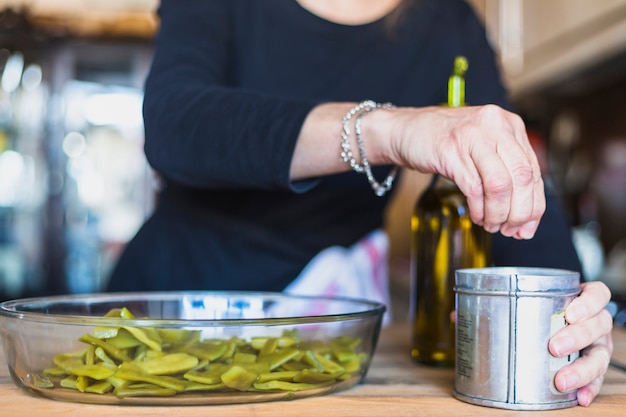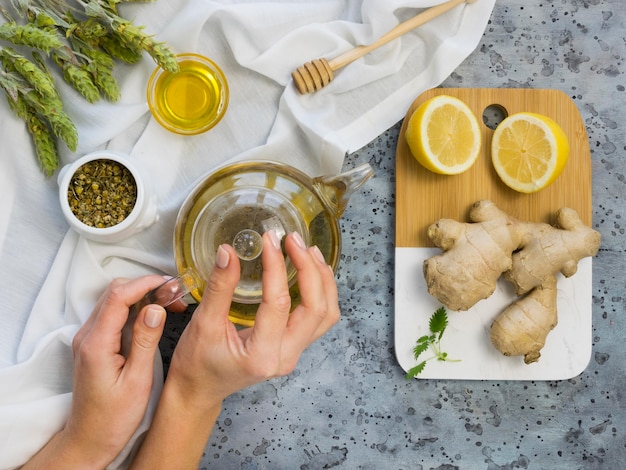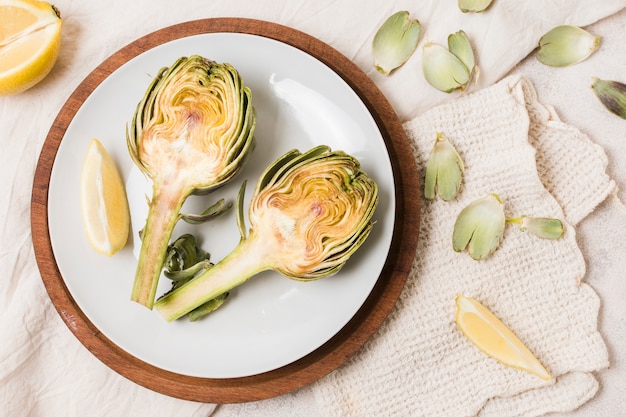(Part 1) Choosing the Perfect Artichoke

Here’s how to find those perfect artichokes:
- Look for artichokes that are firm and heavy for their size. Think of it this way – you want artichokes that feel substantial, not flimsy. This means they’re full of flavour and won't be too watery.
- Avoid artichokes with any signs of damage or wilting. If you see brown spots or a limp base, move on to the next one. You want your artichokes to be fresh and vibrant.
- Check the colour of the leaves. They should be a deep green and feel stiff to the touch. If they're dull or limp, they're probably not going to be as good.
- Try to find artichokes with tight, closed buds. These are the most tender and delicious. You want an artichoke that feels like it's bursting with flavour.
(Part 2) Preparing the Artichoke

Step 1: Trim the Stem
Use a sharp knife to trim the tough bottom of the stem, leaving about 1-2 inches. I like to peel the outer layer of the stem, too, but it’s not essential. This step just gives you a cleaner-looking artichoke.Step 2: Remove the Outer Leaves
Start peeling away the tough outer leaves. You'll notice they're often quite prickly, so use a kitchen towel to help you grip the leaves. You might want to wear gloves, too. Keep removing them until you reach the pale, tender inner leaves.Step 3: Trim the Tips
Once you’ve removed the tough outer leaves, you need to trim the pointy tips off the remaining leaves. These tips are really prickly and will be unappetizing to eat. You can use scissors or a sharp knife for this step.Step 4: Optional: Rub with Lemon
If you want to keep your artichokes from turning brown, you can rub the cut surfaces with a lemon half. This also adds a nice citrusy flavour. You can also add a little lemon juice to the boiling water to help prevent browning.(Part 3) Boiling the Artichoke

Step 1: Fill a Large Pot with Water
Fill a large pot with enough water to cover the artichokes by at least an inch. I like to add a good tablespoon of salt to the water, which helps to season the artichokes. Think of it as giving them a little taste of the sea!Step 2: Add Lemon Juice
Add the juice of one lemon to the water. The lemon juice helps to preserve the artichokes' vibrant green colour and prevents them from turning brown. It also adds a lovely citrusy note to the artichokes.Step 3: Bring the Water to a Boil
Place the pot over high heat and bring the water to a rolling boil. You'll know it's ready when you see the water bubbling furiously.Step 4: Add the Artichokes
Carefully place the prepared artichokes in the boiling water. Make sure they're submerged, but don’t crowd the pot. You want them to have space to cook evenly.Step 5: Reduce Heat and Simmer
Once the artichokes are in the water, reduce the heat to a simmer and cover the pot with a lid. Let them simmer for 30-40 minutes, or until the inner leaves are tender when you pierce them with a fork. This is where patience is key!(Part 4) Testing for Doneness
You've waited patiently for those artichokes to simmer, and now it’s time to check if they're ready.Here's a simple test to check for doneness:
- Use a fork to pierce the base of the artichoke. If it goes in easily, your artichokes are done. If it meets resistance, give them a few more minutes.
(Part 5) Draining and Serving
Your artichokes are cooked, and they’re ready to be unveiled.Step 1: Drain the Artichokes
Carefully remove the artichokes from the boiling water using a slotted spoon. Place them on a plate or in a colander to drain.Step 2: Cool Down
Let the artichokes cool down slightly before you start eating them. This will give them a chance to firm up a bit. You can also use a kitchen towel to pat them dry.Step 3: Enjoy!
That’s it. Now you’ve got perfectly boiled artichokes ready to eat.(Part 6) Delicious Dips and Toppings
Artichokes are delicious on their own, but they're even better with a dip or topping. Here are a few ideas to get you started:Here are a few ideas to get you started:
- Classic: Melted butter is the classic topping for artichokes. It's simple and always satisfying.
- Herby: Aioli is another fantastic option. It’s a garlic-infused mayonnaise that adds a delicious kick to artichokes.
- Spicy: If you like things spicy, try a sriracha mayo. It’s a fun and flavourful way to add a little heat to your artichokes.
- Cheesy: For a more indulgent option, sprinkle some grated Parmesan cheese over your artichokes.
- Lemon-Garlic: A simple lemon-garlic butter sauce is another great choice. It’s light, bright, and compliments the artichoke perfectly.
(Part 7) Making the Most of Your Artichokes
Now that you've boiled those perfect artichokes, what are you going to do with them?Here are some ideas for using your cooked artichokes:
- Serve them as a side dish. Artichokes are a delightful addition to any meal. They're particularly good with grilled fish, chicken, or steak.
- Add them to a salad. The heart of the artichoke is a delicious addition to salads. It adds a unique texture and flavour.
- Use them in a dip or spread. Chopped artichoke hearts can be added to dips, spreads, and even pizza toppings.
- Make artichoke soup. You can use the boiled artichokes to make a delicious and healthy soup.
- Stuff them with your favorite filling. You can stuff artichokes with a variety of fillings, such as sausage, rice, and cheese.
(Part 8) Storage and Leftovers
So you’ve boiled your artichokes and enjoyed them for dinner, but what do you do with the leftovers?Here’s what you need to know about storing and using leftover artichokes:
- Refrigerate in an airtight container. Leftover artichoke hearts can be kept in the refrigerator for up to 3 days.
- Reheat before serving. You can reheat artichoke hearts in the microwave or oven.
- Use in other dishes. Leftover artichokes can be added to pasta dishes, pizzas, or even sandwiches.
(Part 9) Mastering the Art of Artichoke Hearts
Now that you've mastered the art of boiling artichokes, let’s delve into the delicious world of artichoke hearts.Here’s how to get the best artichoke hearts out of your boiled beauties:
- Start at the base. Gently pull the leaves away from the base of the artichoke, starting from the outer leaves and working your way inwards.
- Scoop out the heart. Once you've removed the leaves, you'll be left with the heart of the artichoke. Carefully scoop it out with a spoon.
- Trim any remaining prickly bits. Make sure to remove any prickly bits or tough stems from the artichoke heart before you eat it.
(Part 10) Beyond Boiling
Boiling is the traditional way to cook artichokes, but there are other methods to explore.Here are some alternatives to boiling:
- Steaming: Steaming artichokes is a healthier option, as it doesn't require any added oil or fat. Simply place the artichokes in a steamer basket over boiling water and steam for 30-40 minutes, or until tender.
- Grilling: Grilling artichokes gives them a smoky flavour and a nice char. Simply brush the artichokes with olive oil and grill them for 15-20 minutes, or until tender.
- Roasting: roasted artichokes are tender and flavorful, and they're a great way to use up leftover artichoke hearts. Simply toss the artichoke hearts with olive oil, salt, and pepper, and roast them in a preheated oven at 400 degrees Fahrenheit for 20-25 minutes, or until tender.
(Part 11) Troubleshooting
It happens to the best of us. Sometimes, even with the best intentions, things don't go quite as planned.Here are some common problems you might encounter when boiling artichokes and how to solve them:
- Artichokes are too tough. If your artichokes are too tough, they might not have been cooked long enough. Try adding a few more minutes of simmering time.
- Artichokes are mushy. If your artichokes are mushy, they might have been overcooked. This can happen if you boil them for too long.
- Artichokes are discoloured. If your artichokes turn brown, it's likely because you didn't add enough lemon juice to the water. Next time, add a little extra lemon juice, or rub the cut surfaces with a lemon half before boiling.
(Part 12) FAQs
Let’s address some frequently asked questions about boiling artichokes.1. Can you boil frozen artichoke hearts?
Yes, you can. You can boil frozen artichoke hearts, but they’ll likely be mushy after boiling. It’s best to use frozen artichoke hearts in other dishes like soups, stews, or dips. You can also thaw them before boiling, but you might find that they lose some of their flavor and texture.2. How long do artichokes take to boil?
The amount of time it takes to boil artichokes depends on their size. Smaller artichokes will take about 30 minutes, while larger artichokes may take up to 40 minutes. You can always check for doneness with a fork, as described above.3. What are the health benefits of artichokes?
Artichokes are a good source of fiber, vitamins, and minerals. They're also a good source of antioxidants, which can help protect your cells from damage. They're a great addition to a healthy diet!4. Can you freeze boiled artichokes?
Yes, you can. Freeze the boiled artichokes in an airtight container for up to 3 months. Make sure to cool them down completely before freezing.5. How do you tell if an artichoke is bad?
If an artichoke has any signs of damage, wilting, or discoloration, it's likely bad. You should also avoid artichokes that have a slimy texture or an unpleasant odour. If you're not sure, it's always better to err on the side of caution and choose a different artichoke.(Part 13) Final Thoughts
So there you have it. The ultimate guide to boiling artichokes perfectly. It’s really not that complicated, and the rewards are definitely worth it. Go forth and boil those beautiful artichokes. Enjoy the process, and savor the delicious flavors! Trust me, you won't regret it.Here are some additional tips for boiling artichokes:
- Don't overcrowd the pot. If you're boiling more than one artichoke, make sure they have enough space to cook evenly. You can also boil them in batches if necessary.
- Use a large pot. This will help to ensure that the artichokes have enough room to cook properly.
- Don't overcook the artichokes. Overcooked artichokes will be mushy and will lose their flavor.
- Be patient. Boiling artichokes takes time, so be patient and let them simmer until they are tender.
Everyone is watching

Corn on the Cob: The Ultimate Guide to Perfectly Cooked Ears
Healthy MealsAh, corn on the cob. Just the name evokes images of sunny days, barbecues, and that sweet, juicy flavour that ...

Perfect Pork Roast Oven Cooking Time: A Guide to Delicious Results
Healthy MealsThere's something truly satisfying about a perfectly roasted pork. The aroma alone is enough to make your mout...

Ham Cooking Time: How Long to Bake, Smoke, or Boil a Delicious Ham
Healthy MealsAh, ham. It's a classic, isn't it? A real crowd-pleaser, especially around holidays. And when done right, it'...

Scallops: The Ultimate Guide to Perfect Cooking
Healthy MealsAh, scallops. Those delicate, sweet, and utterly delicious morsels of the sea. They hold a special place in my...

Spaghetti Squash: The Ultimate Guide to Cooking and Serving
Healthy MealsRemember that time you saw spaghetti squash at the supermarket, looking all bumpy and strange, and thought, "W...
